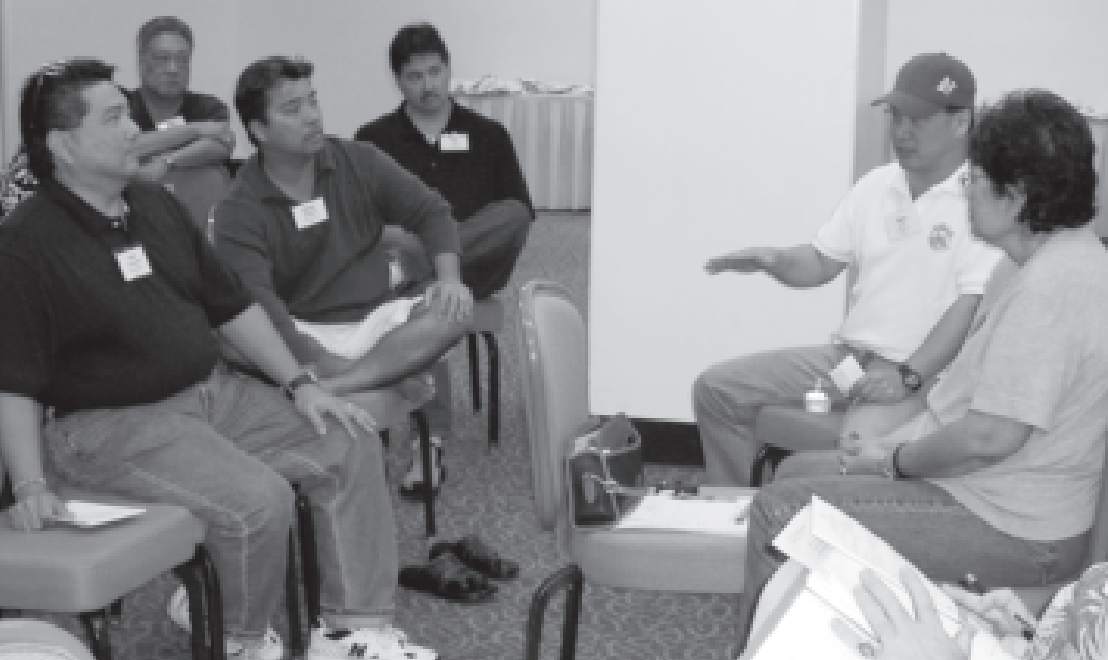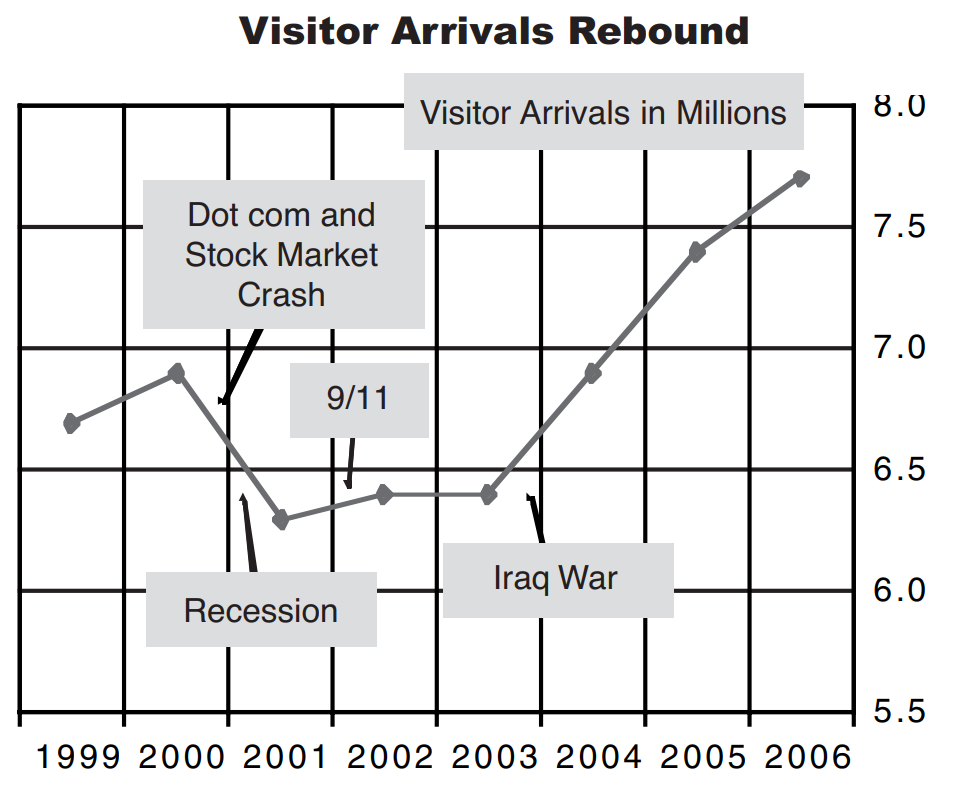Over the next three years, almost the entire membership of the ILWU’s tourism grouping will be negotiating new contracts with the management of their hotels. The tourism grouping is the largest within the union and makes up one-half of the ILWU’s membership of 21,000. The other industrial groups within the ILWU are sugar, longshore, pineapple, and general trades. In 2006, the ILWU will be negotiating contracts covering 2,800 members at 12 hotels. In 2007, only four hotels will be negotiating new contracts, but in 2008, contracts covering 4,700 ILWU members at 10 hotels will be up for renewal. These contracts set the wages, benefits, and working conditions for the unionized hotel workers.

ILWU says aloha and mahalo to Unit 2514 - Kapalua Bay Hotel members. The hotel closed on April 7 and will be razed to make room for a new resort development with transient and residential units. (L-r) Business Agent Wayne Takehara, Kimo Tagupa, Lehua Ii, Kevin Kahalekulu, Janelle Kanekoa, and Business Agent Stephen Castro.
Build unity
Most of the rank-and-file leaders at the conference will probably serve as members of the union’s negotiating committee for their hotels. Within the ILWU, the negotiating process is completely democratic. Members at each hotel give input on proposals and changes they want made in the workplace. They elect a negotiating committee of their coworkers to meet with management. They mobilize to show their solidarity and support for their union, and they vote to approve or reject the final agreement.
This democracy often means that negotiating committee members are more focused on what is happening at their individual hotels. The conference gave them the opportunity to look beyond the immediate issues at their hotel or island and see what was happening to workers in the tourism industry as a whole. It also gave them a chance to meet with their counterparts from hotels all over the state.
Big profits
ILWU hotel members will be seeking their “share of the profits” as the tourism industry has been enjoying its best and most profitable years in history. Visitor arrivals are breaking new records every month. In 2005, visitor arrivals passed the 7 million mark and peaked at 7,379,635. If arrivals continue at the same pace, the number of visitors to Hawaii may pass 8.4 million in 2007.
Hotels are selling more rooms, even as they increase the price to ever higher levels. In fact, since July 2003, revenues per available room has increased an average of 14 percent every month (compared to the same period in the previous year).
In 2005, visitors to Hawaii paid over $2.86 billion to hotels and other vacation rentals for their lodging, for which the state received over $207 million in Transient Accommodations Taxes (TAT). In 2004, hotels collected over $2.62 billion in room revenues. In 2003, room revenues was $2.35 billion—a strong year, but the industry was still recovering from the downturn following the 2001 recession and the disruptions to air travel after the 9/11 attacks on the New York World Trade Center ILWU tconfepreparthe fumembers with high quality and responsive medical care. The ILWU Health and Welfare fund is only one year old—it began operating in January 2005. There were some problems in the beginning, which would be expected from any new operation. But the plan administrators, HMA, have worked Over the next three years, almoILWU’s tourism grouping will be nmanagement of their hotels. Thewithin the union and makes up onof 21,000. The other industrial grlongshore, pineapple, and generanegotiating contracts covering 2,8only four hotels will be negotiatcontracts covering 4,700 ILWU mrenewal. These contracts set thconditions for the unibuilding and the Pentagon.

Big Island participants Frieda Ezzo, Evelyn Giel, Holly Sargent-Green, and Theresa Cabulizan. Job security, wages, and medical were the top three concerns of the hotel membership.
The increase in room revenues in Hawaii and elsewhere are showing up as huge jumps in profits for the big hotel chains. Hilton Hotels posted a corporate-wide operating income of $805 million from $4.48 billion in revenues in 2005. This was an average increase of 25% over the two years since 2003. Starwood Hotels had even better earning results. Starwood’s operating income was $822 million from $5.98 billion in sales in 2005—almost double the income of $427 million in 2003.


A limited supply of rooms is another factor that will push prices even higher. Very few new hotels have been built or are under construction. In addition, some of the older hotels are converting rooms to be sold as timeshare or residential units. The combination of more visitors coming to Hawaii and fewer hotel rooms will push room prices and hotel profits even higher for the near future.
Worker shortages
In the same way that a limited supply of rooms leads to higher prices, a worker shortage will push wages and benefits higher.
Hotels are having a hard time finding workers because of Hawaii’s extremely low unemployment rate of 2.3 percent. The unemployment rate on Maui and Kauai for February 2006 was an even lower 2.2 percent.
This means hotels will need to offer higher wages and benefits to prevent their best workers from finding work in other hotels.
Major concerns for tourism workers
In addition to higher wages, the Conference identified three major issues for the tourism grouping: 1) improving medical benefits by getting more hotels into the ILWU health and welfare fund; 2) strengthening the pension trust fund to provide for adequate retirement benefits; and 3) protecting workers’ jobs and seniority when hotels are sold.
Improving medical benefits
One way to share the profit is to eliminate the worker’s portion of health insurance by providing medical coverage under the ILWU Health and Welfare Trust Fund. The Hilton Waikoloa Village, the Hyatt Regency Maui, and the Grand Hyatt Kauai are currently in the fund and pay 100 percent of the cost of family or single medical coverage for their workers.
Workers benefit because they no longer pay a portion of the medical premium. The hotels benefit because they know what their medical expense is for each year of the collective bargaining agreement with the union. In addition, the fund is better able to manage and control costs.
The fund is jointly managed by a board of trustees chosen by hotel management and the union. The trustees work together to keep expenses down and yet provide members with high quality and responsive medical care.
The ILWU Health and Welfare fund is only one year old—it began operating in January 2005. There were some problems in the beginning, which would be expected from any new operation. But the plan administrators, HMA, have worked quickly to fix problems brought to their attention. Their website is at www.hma-inc.com.

Conference attendees suggested that both members and management need to be educated about how the fund works because it is something new.
Job security
Job security is another major concern for hotel workers. As Hanalei Peters put it, “what good is higher wages and better medical, if you don’t have a job?”
With the booming visitor industry and higher profits, hotel properties are attracting the attention of large investors. In 2004 and 2005, a total of 28 hotels in Hawaii changed ownership. Most of the time the sale had little or no impact on the workers, with only a few changes in top management. But in a growing number of cases, the new owners may fire all of the workers or substantially cut wages and benefits. This happened at the Hawaii Naniloa Hotel when new owner Ken Fujiyama rehired only 20 of the 138 workers—118 workers lost their jobs.
The Conference covered examples of contract language that can protect jobs by making it a condition of the sale of the hotel to require the new owner to maintain the workforce and union contract. Such language protected the members at the Grand Wailea Resort & Spa when Hilton Hotels bought the management contract from KSL.
Strengthening the pension fund
Pensions or retirement benefits have not been a major priority for most union negotiating committees, but the Conference stressed the need to pay more attention to this important benefit.
The workplace pension for hotel members comes from a pension trust fund set up between the hotel industry and the ILWU. The union negotiates the amount each hotel contributes into the fund for every hour a member works. The funds are invested and are used to pay retirement benefits to retired hotel workers.
In the past, the fund grew quickly because of high earnings on investments, the hotel membership was younger, and there were fewer retirees. This situation is different today. The investment market has changed and earnings are much lower then before. The hotel membership is growing older and there are many more retiring workers. This means more money needs to be put into the pension fund, which will require the union to negotiate higher contribution levels from each hotel.
Hotel workers, like most American workers, will need to have retirement money coming from three different sources—from Social Security, from a workplace pension, and from personal savings. To maintain the same standard of living when you retire, your retirement income needs to be around 65-75 percent of your working income. You need less money when you retire, because some of your expenses, such as transportation, is related to your work. ◆

Oahu tourism members Larry Tsuchiyama, Owen Castagan, Darryl Miyashiro and Business Agent Karl Lindo in a small workgroup led by Oahu Division Director Dave Mori and Star Medeiros from Unit 2505 - The Westin Maui.

12 hotels negotiating in 2006—2,800 members
Napili Shores Resort
Maui El Dorado Resort
Renaissance Wailea Beach Resort
Koele Lodge
Manele Bay Hotel
Maui Lu Resort
Molokai Ranch
Royal Lahaina Resort
Kaanapali Beach Hotel
Hapuna Beach Prince Hotel
Pacific Beach Hotel
Honolulu Airport Hotel
4 hotels negotiating in 2007—1,800 members
Maui Prince Hotel
Fairmont Orchid Hawaii Hotel
Hyatt Regency Maui
Diamond Hawaii Resort and Spa
10 hotels negotiating in 2008—4,700 members
Ohana Keauhou Beach Hotel
Mauna Kea Beach Hotel
Grand Wailea Resort
Mauna Lani Bay Hotel
King Kamehameha’s Kona Beach Hotel
Hilton Waikoloa Village
Grand Hyatt Kauai Resort
Sheraton Keauhou Bay Resort
Ritz-Carlton Kapalua
Lahaina Shores Beach Resort
Iwase is ILWU’s choice for governor of Hawaii
Makena, MAUI—One hundred ILWU hotel workers cheered and gave Randy Iwase a standing ovation as he spoke about his vision for a better Hawaii and his reasons for running as the Democratic candidate for governor.
The ILWU officially endorsed Iwase for governor on March 28, 2006, and invited him to speak to a conference of its hotel leadership on May 30 at the Maui Prince Hotel in Wailea, Maui. The rank-and-file leaders came from 29 hotels in the State of Hawaii and represent 11,000 unionized ILWU members. The tourism grouping is the largest within the union and make up one-half of the ILWU’s membership of 22,000. The ILWU also represents thousands of workers in sugar, pineapple, longshore, supermarkets, hospitals and other industries.
“Iwase’s message of a proactive government that takes action to help the working people of Hawaii was well received by our tourism members at this conference,” ILWU President Fred Galdones said. “Hawaii needs a governor like Randy Iwase who truly supports investing more money in public education, who would release the funds to build affordable housing for our elderly, and who takes a stand for workers’ rights at places like the Naniloa Hotel and Del Monte Pineapple.”
The ILWU’s endorsement means the union, its members, and retirees will work actively to support Iwase’s campaign for governor
